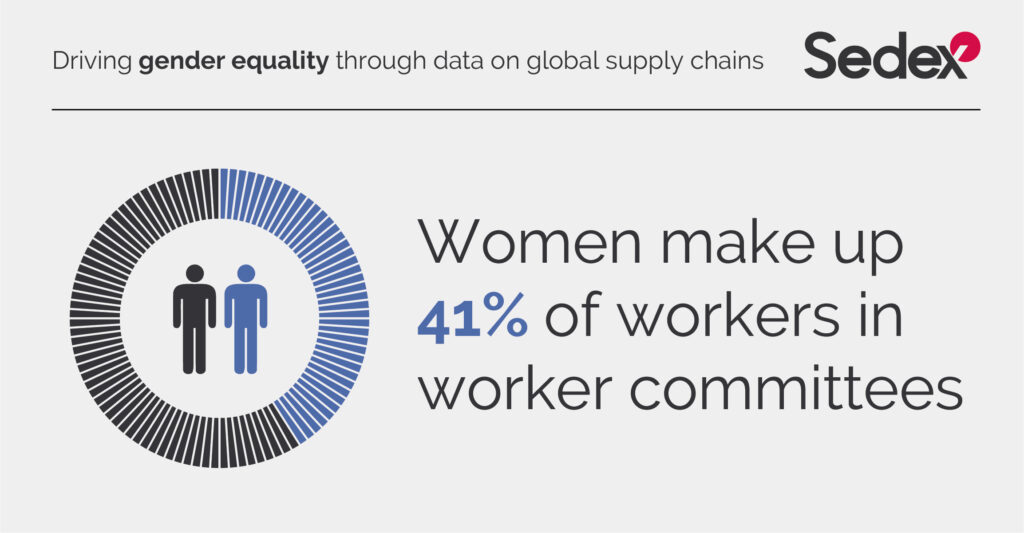Sedex analysis of global supply chain data reveals insights on gender inequalities in the workplace and the power of data for driving equality goals

New analysis from Sedex, one of the world’s leading ethical trade membership organisations, reveals insights on gender roles within global supply chains from its members, as it calls for all businesses to collect gender data.
Using data that is separated by gender, collected from 42,000 business sites, across 143 countries and 12.5m workers, the analysis highlights that women make up nearly half (43%) of the global workforce, but hold only a quarter (27%) of management positions and a third (31%) of supervisor roles. Women are also less likely to be promoted, with an average of 38% of promotions in the past year going to women and 62% going to men.
The data was collected through the Sedex ethical data platform, which contains information from tens of thousands of businesses within supply chains and millions of workers across the globe. The organisation is using this layer of data to drive initiatives from buyers and suppliers throughout the supply chain, with the aim of improving gender equality within work.
The full findings and analysis can be found in Sedex’s recent insights report <title> launched today.
Commenting on the findings, Jessica McGoverne, Director of Policy and Corporate Affairs at Sedex says: “Without gender data, businesses cannot understand where women are disadvantaged and what progress is being made on women’s economic empowerment. Working with our members, we’re helping them to identify, through our platform, where the gender risks are, and how they can support better working conditions through their partners across the supply chain.
“Inequality between men and women in management positions, for example, can be a barrier to better pay and professional development opportunities, and can also be a factor of increased risks of violence and harassment against women in the workplace.
“It’s therefore never been more important for all parties – both buyers and suppliers – to collect gender data on workers throughout the supply chain. If you have accurate data, you can take action to boost equality for millions of people.”
Jiselle Steele, Private Sector Gender Advisor, Oxfam Business Advisory Service says: “Oxfam’s research shows that to tackle gender inequality in supply chains, companies need to collect the right data. Gender-disaggregated data enables companies along the value chain to identify the workplace issues that disproportionately impact women; understand the barriers to women’s representation; and establish where the gender pay gaps are. This can then be used to support women’s access to dignified work and human rights”.
Female representation in roles and sectors
The report also revealed that in certain sectors and roles, gender imbalances are particularly prominent. These typically follow traditional gender norms of male-dominant and female-dominant industries.
For example, the data revealed that women’s workforce participation is 69% in human health activities, 62% in the apparel manufacturing sector, and 60% in services to buildings and landscape activities (inc. cleaning). However, women make up just 26% in computer programming, consultancy and related activities, 21% in security and investigation and just 14% in specialised construction roles. These three sectors require specialised, more technical skills, and are also typically better paid.
The agriculture and apparel manufacturing sectors have the largest gaps between men and women when comparing workforce composition against the workplace equality data points included in the report. These sectors are also recognised as having labour-intensive and low-skilled work within their supply chains, are reliant on migrant labour, and often have tough conditions that put workers’ health and safety at risk.
Women underrepresented on worker committees
One solution to promote better working conditions for women lies in greater female representation on worker committees. These provide channels through which workers can raise issues and concerns to management. Collective bargaining opportunities provided by worker committees (and other forms of associations) allow workers to drive positive change.
But worker committees don’t always reflect the proportion of female workers. In apparel manufacturing, women make up 49% of worker committees, despite being 62% of the workforce. And in agriculture, women are 44% of the workforce but make up 38% on worker committees.
These issues also have an impact on the breadth of some of Sedex’s insights. At an aggregate level, more than 80% of sites did not provide gender-disaggregated information for promotions or worker committees. Over 90% did not separate data on worker grievances by gender.
McGoverne adds: “Clearly, it’s never been more important to have data on women’s representation in business, to help empower women and improve their working conditions. Through this report, we’re calling on all businesses to further identify and commit to collecting key gender data indicators, which will make it easier to identify where women aren’t being treated equally at work. If you can identify this, you can start to make a real difference across the globe for gender equality.”
Full details about Sedex’s Gender Data Insights report can be read here: https://www.sedex.com/global-supply-chain-data-reveals-gender-inequalities-in-the-workplace-and-highlights-the-power-of-data-for-driving-equality/



